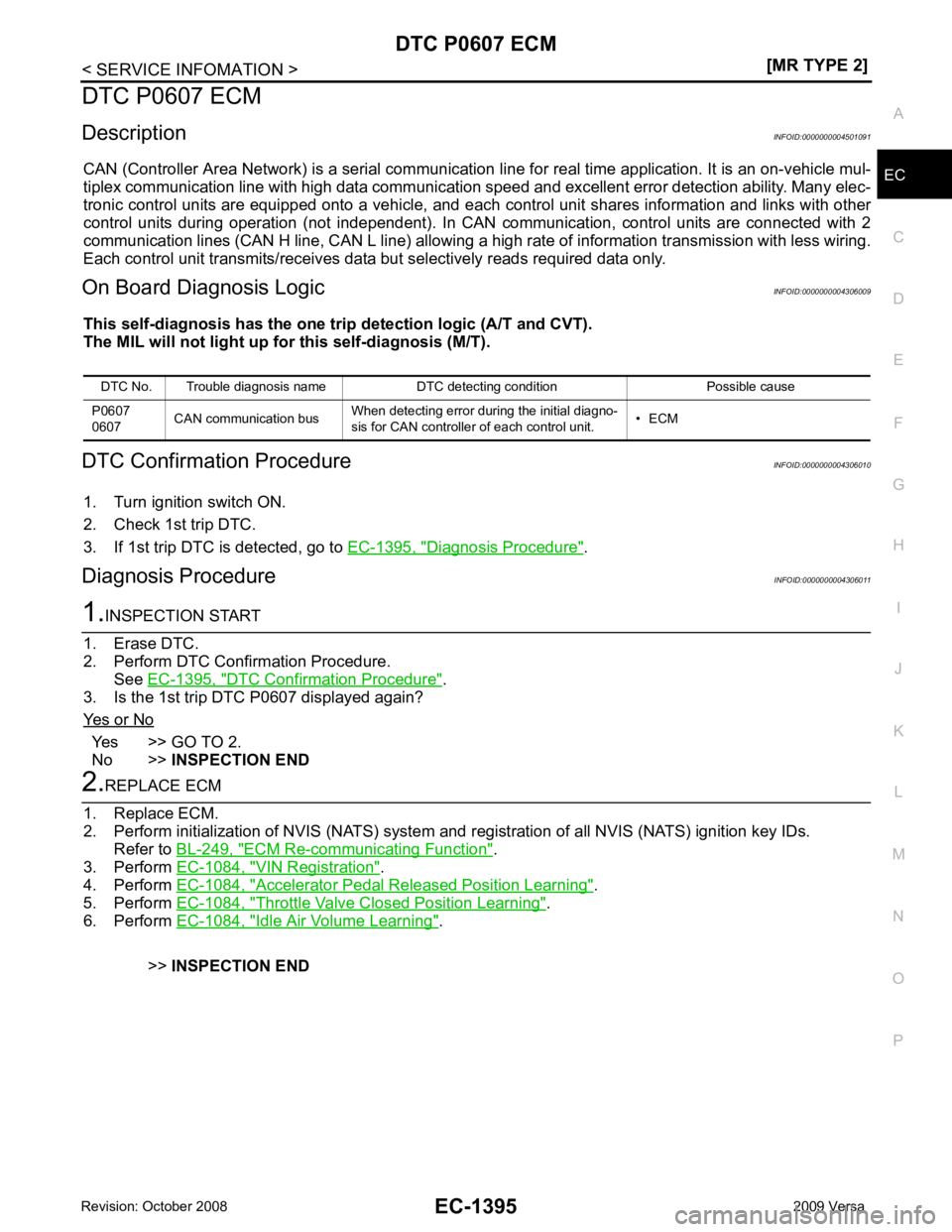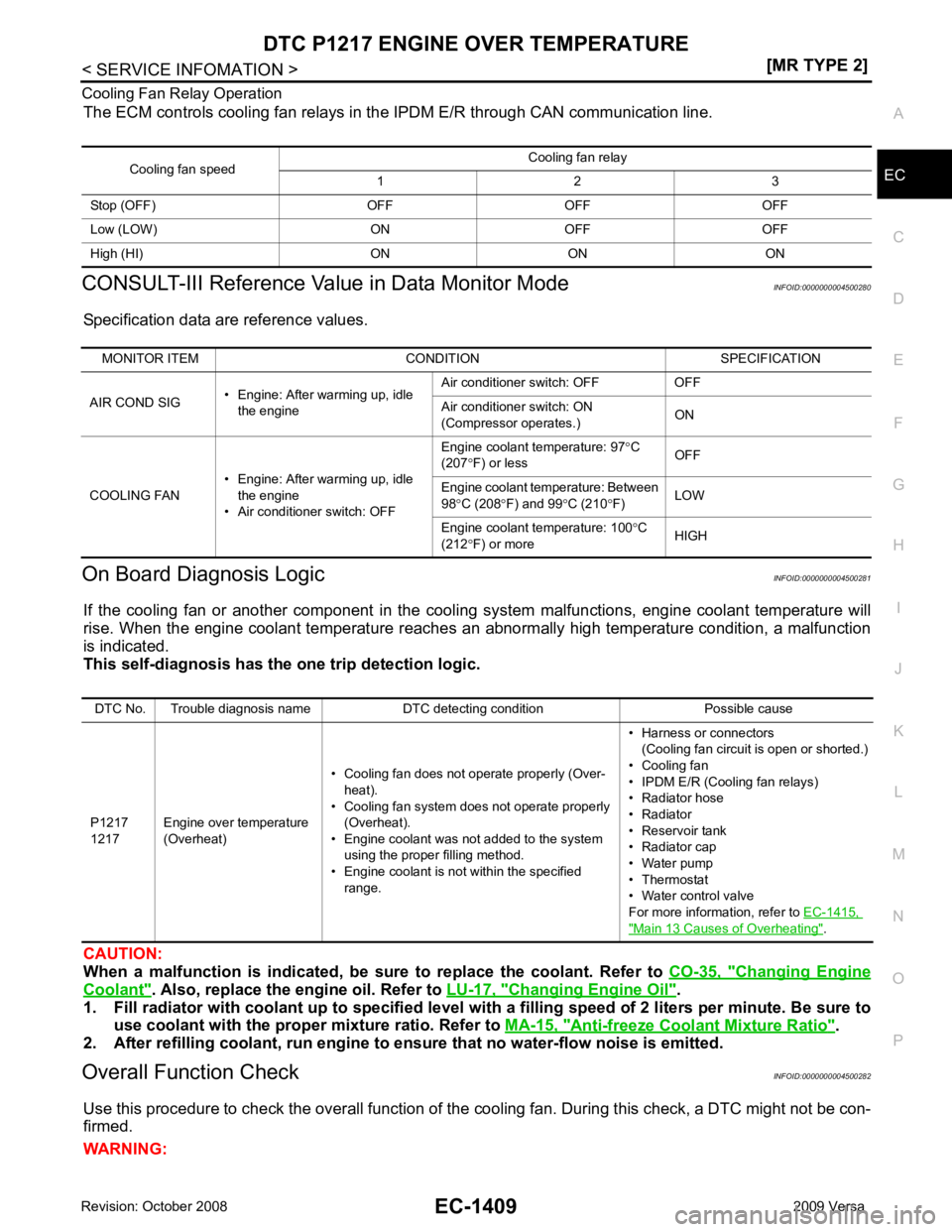2009 NISSAN LATIO air condition
[x] Cancel search: air conditionPage 2747 of 4331

EC
NP
O
DTC P0507 ISC SYSTEM
Description INFOID:0000000004500259
NOTE:
If DTC P0507 is displayed with ot her DTC, first perform the trouble diagnosis for the other DTC.
The ECM controls the engine idle speed to a specified leve l through the fine adjustment of the air, which is let
into the intake manifold, by operating the electric thrott le control actuator. The operating of the throttle valve is
varied to allow for optimum control of the engine id ling speed. The ECM calculates the actual engine speed
from signals of camshaft position sensor (POS) and camshaft position sensor (PHASE).
The ECM controls the electric throttle control actuator so that the engine speed coincides with the target value
memorized in the ECM. The target engine speed is t he lowest speed at which the engine can operate steadily.
The optimum value stored in the ECM is determined by taking into consideration various engine conditions,
such as during warming up, deceleration, and engine load (air conditioner, power steering and cooling fan
operation, etc.).
On Board Diagnosis Logic INFOID:0000000004500260
DTC Confirmation Procedure INFOID:0000000004500261
NOTE:
• If DTC Confirmation Procedure has been previously conduc ted, always turn ignition switch OFF and wait at
least 10 seconds before conducting the next test.
• If the target idle speed is out of the specified value, perform EC-1084, " Idle Air Volume Learning " ,
before conducting DTC Confirmation Procedure. For the target idle speed, refer to the EC-1534 .
TESTING CONDITION:
• Before performing the following procedure, confirm that battery voltage is more than 11V at idle.
• Always perform the test at a temperature above −10 °C (14 °F).
1. Open engine hood.
2. Start engine and warm it up to normal operating temperature.
3. Turn ignition switch OFF and wait at least 10 seconds.
4. Start engine and run it for at least 1 minute at idle speed.
5. Check 1st trip DTC.
6. If 1st trip DTC is detected, go to EC-1391, " Diagnosis Procedure " .
Diagnosis Procedure INFOID:0000000004500262OK >> GO TO 2.
NG >> Repair or replace. OK >> GO TO 3.
NG >> Discover air leak location and repair.
Page 2751 of 4331

EC
NP
O
DTC P0607 ECM
Description INFOID:0000000004501091
CAN (Controller Area Network) is a serial communication li ne for real time application. It is an on-vehicle mul-
tiplex communication line with high data communication speed and excellent error detection ability. Many elec-
tronic control units are equipped onto a vehicle, and each control unit shares information and links with other
control units during operation (not independent). In CAN communication, control units are connected with 2
communication lines (CAN H line, CAN L line) allowing a high rate of information transmission with less wiring.
Each control unit transmits/receives data but selectively reads required data only.
On Board Diagnosis Logic INFOID:0000000004306009
This self-diagnosis has the one trip detection logic (A/T and CVT).
The MIL will not light up for this self-diagnosis (M/T).
DTC Confirmation Procedure INFOID:0000000004306010
1. Turn ignition switch ON.
2. Check 1st trip DTC.
3. If 1st trip DTC is detected, go to EC-1395, " Diagnosis Procedure " .
Diagnosis Procedure INFOID:0000000004306011DTC Confirmation Procedure " .
3. Is the 1st trip DTC P0607 displayed again?
Yes or No Yes >> GO TO 2.
No >> INSPECTION END ECM Re-communicating Function " .
3. Perform EC-1084, " VIN Registration " .
4. Perform EC-1084, " Accelerator Pedal Released Position Learning " .
5. Perform EC-1084, " Throttle Valve Closed Position Learning " .
6. Perform EC-1084, " Idle Air Volume Learning " .
>> INSPECTION END
DTC No. Trouble diagnosis name DTC detecting condition Possible cause
P0607
0607 CAN communication bus
When detecting error during the initial diagno-
sis for CAN controller of each control unit. • ECM
Page 2754 of 4331
![NISSAN LATIO 2009 Service Repair Manual EC-1398< SERVICE INFOMATION >
[MR TYPE 2]
DTC P0643 SENSOR POWER SUPPLY
Diagnosis Procedure INFOID:00000000045002701.
CHECK GROUND CONNECTIONS
1. Turn ignition switch OFF.
2. Loosen and retighten grou NISSAN LATIO 2009 Service Repair Manual EC-1398< SERVICE INFOMATION >
[MR TYPE 2]
DTC P0643 SENSOR POWER SUPPLY
Diagnosis Procedure INFOID:00000000045002701.
CHECK GROUND CONNECTIONS
1. Turn ignition switch OFF.
2. Loosen and retighten grou](/manual-img/5/57359/w960_57359-2753.png)
EC-1398< SERVICE INFOMATION >
[MR TYPE 2]
DTC P0643 SENSOR POWER SUPPLY
Diagnosis Procedure INFOID:00000000045002701.
CHECK GROUND CONNECTIONS
1. Turn ignition switch OFF.
2. Loosen and retighten ground screws on the body.
Refer to EC-1144, " Ground Inspection " .
OK or NG OK >> GO TO 2.
NG >> Repair or replace ground connections. TER-
MI-
NAL
NO. WIRE
COLOR ITEM CONDITION DATA (DC Voltage)
72 V Sensor power supply
(Throttle position sensor) [Ignition switch: ON]
Approximately 5V
78 O Sensor power supply
[Camshaft position sensor
(PHASE)] [Ignition switch: ON]
Approximately 5V
102 SB Sensor power supply
(APP sensor 2) [Ignition switch: ON]
Approximately 5V
103 GR Accelerator pe
dal position
sensor 2 [Ignition switch: ON]
• Engine stopped
• Accelerator pedal: Fully released 0.3 - 0.6V
[Ignition switch: ON]
• Engine stopped
• Accelerator pedal: Fully depressed 1.95 - 2.4V
104 Y Sensor ground
(APP sensor 2) [Engine is running]
• Warm-up condition
• Idle speed Approximately 0V
106 P Sensor power supply
(APP sensor 1) [Ignition switch: ON]
Approximately 5V
110 G Accelerator pe
dal position
sensor 1 [Ignition switch: ON]
• Engine stopped
• Accelerator pedal: Fully released 0.6 - 0.9V
[Ignition switch: ON]
• Engine stopped
• Accelerator pedal: Fully depressed 3.9 - 4.7V
111 R Sensor ground
(APP sensor 1) [Engine is running]
• Warm-up condition
• Idle speed Approximately 0V:
Vehicle front
1. Body ground E24 2. Engine ground F9 3. Engine ground F16
4. Body ground E15 BBIA0698E
Page 2760 of 4331
![NISSAN LATIO 2009 Service Repair Manual EC-1404< SERVICE INFOMATION >
[MR TYPE 2]
DTC P0850 PNP SWITCH
Diagnosis Procedure INFOID:0000000004500277
A/T MODELS AND CVT MODELS 1.
CHECK PNP SWITCH POWER SUPPLY CIRCUIT
1. Turn ignition switch OF NISSAN LATIO 2009 Service Repair Manual EC-1404< SERVICE INFOMATION >
[MR TYPE 2]
DTC P0850 PNP SWITCH
Diagnosis Procedure INFOID:0000000004500277
A/T MODELS AND CVT MODELS 1.
CHECK PNP SWITCH POWER SUPPLY CIRCUIT
1. Turn ignition switch OF](/manual-img/5/57359/w960_57359-2759.png)
EC-1404< SERVICE INFOMATION >
[MR TYPE 2]
DTC P0850 PNP SWITCH
Diagnosis Procedure INFOID:0000000004500277
A/T MODELS AND CVT MODELS 1.
CHECK PNP SWITCH POWER SUPPLY CIRCUIT
1. Turn ignition switch OFF.
2. Disconnect PNP switch harness connector.
3. Turn ignition switch ON.
4. Check voltage between PNP switch terminal 1 and ground with CONSULT-III or tester.
OK or NG OK >> GO TO 3.
NG >> GO TO 2. 2.
DETECT MALFUNCTIONING PART
Check the following.
• Harness connectors E8, F8
• Harness for open or short between PNP switch and fuse
>> Repair open circuit or short to ground or short to power in harness or connectors. 3.
CHECK PNP SWITCH INPUT SIGNAL CIRCUIT FOR OPEN AND SHORT
1. Turn ignition switch OFF.
2. Disconnect ECM harness connector.
3. Check harness continuity between PNP switch terminal 2 and ECM terminal 69. Refer to Wiring Diagram.
4. Also check harness for short to ground and short to power.
OK or NG OK >> GO TO 4.
NG >> Repair open circuit or short to ground or short to power in harness or connectors. TERMI-
NAL NO. WIRE
COLOR ITEM CONDITION DATA (DC Voltage)
69 L Park/neutral position
(PNP) switch [Ignition switch: ON]
• Shift lever: P or N (A/T, CVT), Neutral (M/T) BATTERY VOLTAGE
(11 - 14V)
[Ignition switch: ON]
• Except above Approximately 0V A/T CVT
Voltage: Battery voltage PBIB3002E JMBIA2080ZZ
Continuity should exist.
Page 2763 of 4331

EC
NP
O
DTC P1148 CLOSED LOOP CONTROL
On Board Diagnosis Logic INFOID:0000000004500278
This self-diagnosis has the on e trip detection logic.
NOTE:
DTC P1148 is displayed with another DTC fo r air fuel ratio (A/F) sensor 1.
Perform the trouble diagnosis for the corresponding DTC. DTC No. Trouble diagnosis name DTC detecting condition Possible cause
P1148
1148 Closed loop control
function The closed loop control function does not oper-
ate even when vehicle is driving in the specified
condition. • Harness or connectors
[Air fuel ratio (A/F) sensor 1 circuit is open
or shorted.]
• Air fuel ratio (A/F) sensor 1
• Air fuel ratio (A/F) sensor 1 heater
Page 2764 of 4331
![NISSAN LATIO 2009 Service Repair Manual EC-1408< SERVICE INFOMATION >
[MR TYPE 2]
DTC P1217 ENGINE
OVER TEMPERATURE
DTC P1217 ENGINE OVER TEMPERATURE
System Description INFOID:0000000004500279
SYSTEM DESCRIPTION
NOTE:
• If DTC P1217 is d NISSAN LATIO 2009 Service Repair Manual EC-1408< SERVICE INFOMATION >
[MR TYPE 2]
DTC P1217 ENGINE
OVER TEMPERATURE
DTC P1217 ENGINE OVER TEMPERATURE
System Description INFOID:0000000004500279
SYSTEM DESCRIPTION
NOTE:
• If DTC P1217 is d](/manual-img/5/57359/w960_57359-2763.png)
EC-1408< SERVICE INFOMATION >
[MR TYPE 2]
DTC P1217 ENGINE
OVER TEMPERATURE
DTC P1217 ENGINE OVER TEMPERATURE
System Description INFOID:0000000004500279
SYSTEM DESCRIPTION
NOTE:
• If DTC P1217 is displayed with DTC UXXXX, first perform the tr ouble diagnosis for DTC UXXXX.
• If DTC P1217 is displayed with DTC P0607, first pe rform the trouble diagnosis for DTC P0607. Refer
to EC-1395 .
Cooling Fan Control
*1: The ECM determines the start signal status by the signals of engine speed and battery voltage.
*2: This signal is sent to ECM through CAN communication line.
The ECM controls the cooling fan corresponding to the vehicle speed, engine coolant temperature, refrigerant
pressure, and air conditioner ON signal. The contro l system has 3-step control [HIGH/LOW/OFF].
Cooling Fan Operation
Models with A/C
Models without A/C Sensor Input Signal to ECM ECM function Actuator
Crankshaft position sensor (POS)
Camshaft position sensor (PHASE) Engine speed*
1
Cooling fan
control IPDM E/R
(Cooling fan relays)
Battery
Battery voltage*1
ABS actuator and electric unit (control unit)
Vehicle speed*2
Combination meter
Engine coolant temperature sensor Engine coolant temperature
Air conditioner switch Air conditioner ON signal*2
Refrigerant pressure sensor Refrigerant pressure PBIB2483E
PBIB3335E
Page 2765 of 4331

EC
NP
O
Cooling Fan Relay Operation
The ECM controls cooling fan relays in the IPDM E/R through CAN communication line.
CONSULT-III Reference Val ue in Data Monitor Mode INFOID:0000000004500280
Specification data are reference values.
On Board Diagnosis Logic INFOID:0000000004500281
If the cooling fan or another component in the cooli ng system malfunctions, engine coolant temperature will
rise. When the engine coolant temperature reaches an abnormally high temperature condition, a malfunction
is indicated.
This self-diagnosis has the on e trip detection logic.
CAUTION:
When a malfunction is in dicated, be sure to replace the coolant. Refer to CO-35, " Changing Engine
Coolant " . Also, replace the engine oil. Refer to
LU-17, " Changing Engine Oil " .
1. Fill radiator with coolant up to specified level with a filling speed of 2 liters per minute. Be sure to
use coolant with the proper mixture ratio. Refer to MA-15, " Anti-freeze Coolant Mixture Ratio " .
2. After refilling coolant, run engine to ensure that no water-flow noise is emitted.
Overall Function Check INFOID:0000000004500282
Use this procedure to check the overall function of the cooling fan. During this check, a DTC might not be con-
firmed.
WARNING: Cooling fan speed
Cooling fan relay
1 2 3
Stop (OFF) OFF OFF OFF
Low (LOW) ON OFF OFF
High (HI) ON ON ON MONITOR ITEM CONDITION SPECIFICATION
AIR COND SIG • Engine: After warming up, idle
the engine Air conditioner switch: OFF OFF
Air conditioner switch: ON
(Compressor operates.) ON
COOLING FAN • Engine: After warming up, idle
the engine
• Air conditioner switch: OFF Engine coolant temperature: 97
°C
(207 °F) or less OFF
Engine coolant temperature: Between
98 °C (208 °F) and 99 °C (210 °F) LOW
Engine coolant temperature: 100 °C
(212 °F) or more HIGHDTC No. Trouble diagnosis name DTC detecting condition Possible cause
P1217
1217 Engine over temperature
(Overheat) • Cooling fan does not operate properly (Over-
heat).
• Cooling fan system does not operate properly (Overheat).
• Engine coolant was not added to the system using the proper filling method.
• Engine coolant is not within the specified
range. • Harness or connectors
(Cooling fan circuit is open or shorted.)
• Cooling fan
• IPDM E/R (Cooling fan relays)
• Radiator hose
• Radiator
• Reservoir tank
• Radiator cap
• Water pump
• Thermostat
• Water control valve
For more information, refer to EC-1415, " Main 13 Causes of Overheating " .
Page 2773 of 4331
![NISSAN LATIO 2009 Service Repair Manual DTC P1225 TP SENSOR
EC-1417
< SERVICE INFOMATION >
[MR TYPE 2] C
D E
F
G H
I
J
K L
M A EC
NP
O
DTC P1225 TP SENSOR
Component Description INFOID:0000000004500287
Electric throttle control actuator NISSAN LATIO 2009 Service Repair Manual DTC P1225 TP SENSOR
EC-1417
< SERVICE INFOMATION >
[MR TYPE 2] C
D E
F
G H
I
J
K L
M A EC
NP
O
DTC P1225 TP SENSOR
Component Description INFOID:0000000004500287
Electric throttle control actuator](/manual-img/5/57359/w960_57359-2772.png)
DTC P1225 TP SENSOR
EC-1417
< SERVICE INFOMATION >
[MR TYPE 2] C
D E
F
G H
I
J
K L
M A EC
NP
O
DTC P1225 TP SENSOR
Component Description INFOID:0000000004500287
Electric throttle control actuator consists of throttle control motor,
throttle position sensor, etc. The throttle position sensor responds to
the throttle valve movement.
The throttle position sensor has two sensors. These sensors are a
kind of potentiometers which transform the throttle valve position into
output voltage, and emit the voltage signal to the ECM. In addition,
these sensors detect the opening and closing speed of the throttle
valve and feed the voltage signals to the ECM. The ECM judges the
current opening angle of the throttle valve from these signals and the
ECM controls the throttle control motor to make the throttle valve
opening angle properly in response to driving condition.
On Board Diagnosis Logic INFOID:0000000004500288
The MIL will not light up for this diagnosis.
DTC Confirmation Procedure INFOID:0000000004500289
NOTE:
If DTC Confirmation Procedure has been previously conduc ted, always turn ignition switch OFF and wait at
least 10 seconds before conducting the next test.
TESTING CONDITION:
Before performing the following procedure, confirm that battery voltage is more than 10V at idle.
1. Turn ignition switch ON.
2. Turn ignition switch OFF and wait at least 10 seconds.
3. Turn ignition switch ON.
4. Check 1st trip DTC.
5. If 1st trip DTC is detected, go to EC-1417, " Diagnosis Procedure " .
Diagnosis Procedure INFOID:00000000045002901.
CHECK ELECTRIC THROTTLE CONTROL ACTUATOR VISUALLY
1. Turn ignition switch OFF.
2. Remove the intake air duct.
3. Check if foreign matter is c aught between the throttle valve (1)
and the housing.
- : Vehicle front
OK or NG OK >> GO TO 2.
NG >> Remove the foreign matter and clean the electric throttle
control actuator inside. 2.
REPLACE ELECTRIC THROTTLE CONTROL ACTUATOR
1. Replace the electric throttle control actuator.
2. Perform EC-1084, " Throttle Valve Closed Position Learning " .
3. Perform EC-1084, " Idle Air Volume Learning " . PBIB0145E
DTC No. Trouble diagnosis name DTC detecting condition Possible cause
P1225
1225 Closed throttle position
learning performance Closed throttle position learning value is exces-
sively low. • Electric throttle control actuator
(TP sensor 1 and 2) BBIA0711E